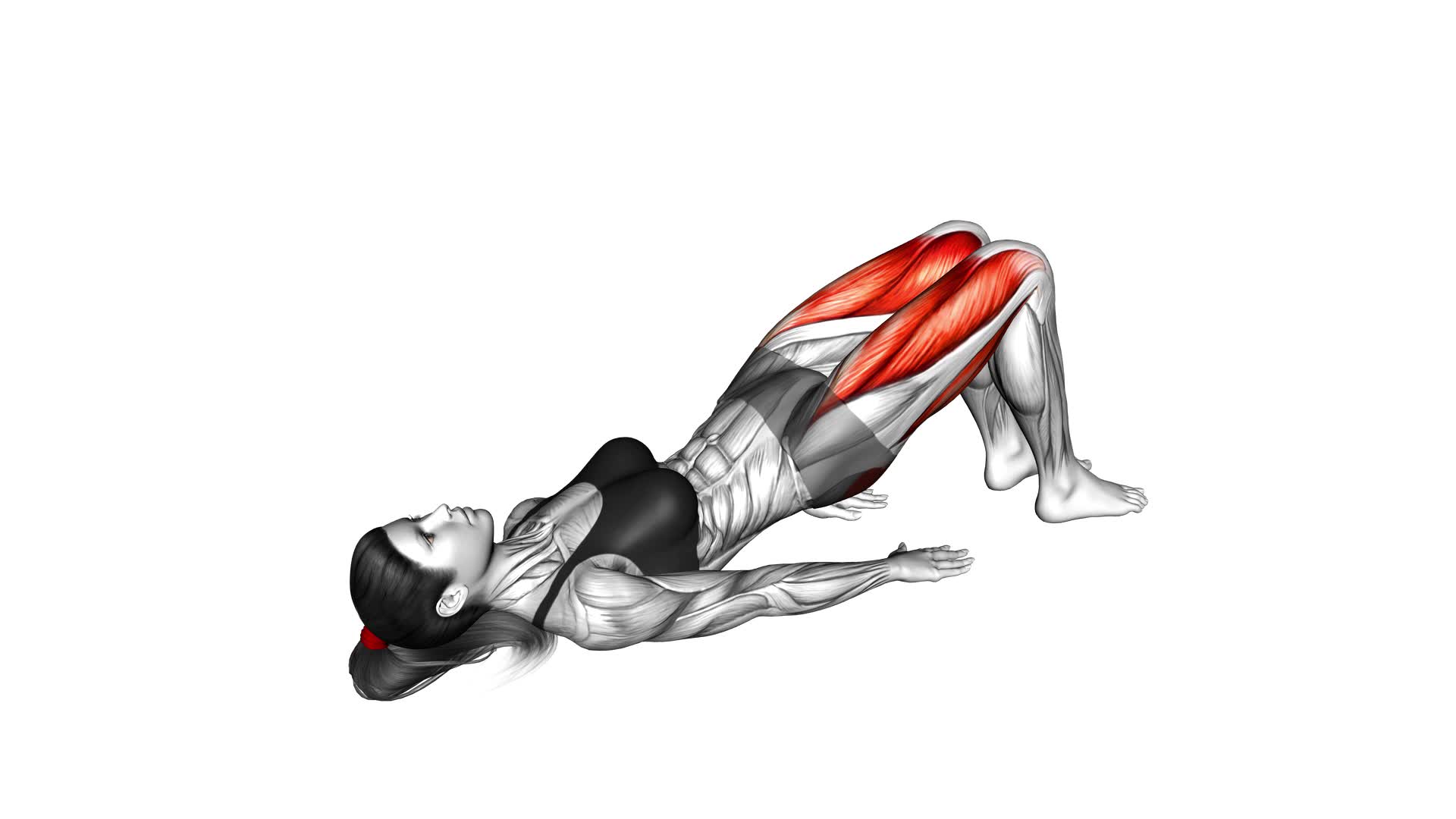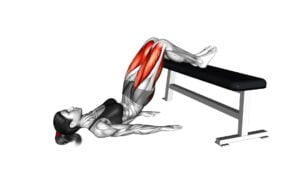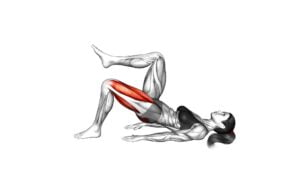Glute Bridge Two Legs on Floor (female) – Video Exercise Guide & Tips

Get ready to sculpt and strengthen your glutes with the glute bridge exercise!
Watch This Exercise Video
In this video exercise guide, we'll show you how to perform the glute bridge with both legs on the floor, specifically targeting the female body. By following proper form and technique, you'll activate those glute muscles and reap the benefits of a firmer, rounder backside.
Avoid common mistakes, maximize your results, and check out our sample workout routine to take your glute bridge to the next level.
Let's get those glutes firing!
Key Takeaways
- Activates and strengthens glutes
- Improves athletic performance and reduces risk of injury
- Targets posterior chain muscles (hamstrings, lower back)
- Enhances core stability and balance
Benefits of the Glute Bridge
There are five key benefits to incorporating the glute bridge into your workout routine.
Glute bridge exercises are an effective way to activate and strengthen your glutes, which are the largest muscles in your body. By engaging your glutes, you can improve your overall athletic performance and reduce the risk of injury.
One of the main benefits of glute bridge exercises is glute activation. These exercises specifically target your glutes, helping to activate and engage them. This is important because many people have weak glutes, which can lead to imbalances and compensations in other areas of the body. By strengthening your glutes through glute bridge exercises, you can improve your posture, stability, and overall movement mechanics.
Additionally, the glute bridge is a great exercise for targeting the muscles in your posterior chain, including your hamstrings and lower back. By strengthening these muscles, you can improve your hip mobility, reduce lower back pain, and enhance your overall athletic performance.
Incorporating the glute bridge into your workout routine can also help to improve your core stability. During the exercise, you need to engage your core muscles to maintain a stable and neutral spine. This can help to improve your overall balance and stability, both in and out of the gym.
In conclusion, the glute bridge provides several key benefits, including glute activation, improved posterior chain strength, and enhanced core stability.
Now, let's move on to discussing proper form and technique for performing the glute bridge.
Proper Form and Technique
To perform the Glute Bridge with proper form and technique, it's essential to focus on two key points: hip alignment and stability, and core engagement and activation.
Ensuring that your hips are aligned and stable throughout the movement will help maximize the effectiveness of the exercise and prevent any strain or injury.
Additionally, engaging and activating your core muscles will provide stability and support to your spine, allowing you to maintain proper form and get the most out of each repetition.
Hip Alignment and Stability
You can improve your hip alignment and stability during the Glute Bridge Two Legs on Floor exercise by focusing on proper form and technique.
Maintaining pelvic stability is crucial for this exercise. Start by lying flat on your back with your knees bent and feet flat on the ground.
Engage your core and squeeze your glutes as you lift your hips off the floor, forming a straight line from your knees to your shoulders. Avoid letting your knees collapse inward or flare out.
Keep your hips level and avoid excessive arching or tucking of the pelvis.
Core Engagement and Activation
To properly engage and activate your core during the Glute Bridge Two Legs on Floor exercise, focus on maintaining proper form and technique. This will ensure that you're effectively targeting your glutes while also strengthening your core. Here are three key strategies to help you maximize your core engagement and activation:
- Maintain a neutral spine: Keep your back flat against the floor throughout the entire movement. Avoid arching or rounding your lower back, as this can take the focus away from your core.
- Engage your deep core muscles: Imagine drawing your belly button towards your spine. This will activate your deep core muscles, such as the transverse abdominis, and provide stability during the exercise.
- Breathe properly: Inhale deeply before lifting your hips off the ground and exhale as you lift. This coordinated breathing will help engage your core and enhance your glute activation.
By following these core engagement techniques, you'll maximize the effectiveness of the exercise and ensure proper muscle activation.
Now, let's explore some variations and progressions to take your Glute Bridge Two Legs on Floor to the next level.
Variations and Progressions
Now that you have mastered the glute bridge with both legs on the floor, it's time to explore some variations and progressions to challenge your glutes even more.
One option is to add resistance bands around your thighs to increase the intensity and engage your glute muscles even further.
Another progression is to try the single leg glute bridge, which requires more stability and works each glute individually.
Lastly, you can experiment with elevated surface variations, such as using a stability ball or bench, to further target your glutes and increase the range of motion.
Keep pushing yourself and trying these variations to continuously challenge and strengthen your glutes.
Adding Resistance Bands
Enhance your glute bridge exercise by incorporating resistance bands for added intensity and muscle activation. Resistance bands are a great tool to increase the challenge and target your glutes even more effectively.
Here are three variations of the glute bridge exercise using resistance bands:
- Band above knees: Place a resistance band just above your knees. As you bridge up, push your knees out against the band, engaging your glute muscles even more.
- Band around thighs: Position the band around your thighs, slightly above your knees. As you bridge up, focus on pushing your thighs out against the band, activating your glutes and outer hip muscles.
- Band around ankles: Loop the band around your ankles. As you bridge up, push your ankles out against the band, activating your glutes and targeting the muscles on the back of your legs.
Incorporating resistance bands into your glute bridge exercise won't only add variety but also increase the challenge and effectiveness of the exercise. Give these variations a try and feel the burn in your glutes!
Single Leg Progression
To progress the glute bridge exercise, incorporate single leg variations to intensify the workout and target specific muscles.
Single leg glute bridges are a great way to challenge your balance, stability, and strength. By lifting one leg off the floor while performing the exercise, you engage the glutes, hamstrings, and core even more. This modification also helps to correct any muscle imbalances that may exist between your left and right sides.
For runners, single leg glute bridges can be especially beneficial. They help to activate and strengthen the glute muscles, which are crucial for power and stability during running.
Elevated Surface Variations
Challenge yourself with elevated surface variations to take your glute bridge workout to the next level. These advanced glute bridge exercises will target your glutes and hamstrings even more intensely, helping you build strength and improve your overall fitness.
Here are three variations you can try:
- Bench Glute Bridge: Place your upper back and shoulders on a bench or step, and keep your feet flat on the ground. Lift your hips up, squeezing your glutes at the top, and then lower back down.
- Swiss Ball Glute Bridge: Position a Swiss ball under your feet, with your upper back and shoulders on the floor. Lift your hips up, using your glutes to roll the ball towards you, and then roll it back out.
- Single Leg Elevated Glute Bridge: Elevate one foot on a step or bench, and keep the other foot on the ground. Lift your hips up using the grounded foot, focusing on squeezing the glutes of the elevated leg.
Incorporate these glute bridge variations into your routine to challenge your muscles and see great results. Keep pushing yourself and enjoy the benefits of a stronger lower body.
Common Mistakes to Avoid
To avoid common mistakes while performing the Glute Bridge Two Legs on Floor exercise, make sure that you maintain proper form and engage the correct muscles throughout the movement. One common mistake to avoid isn't keeping your feet hip-width apart. When your feet are too close together, it can create instability and make it difficult to activate the glutes effectively. Another mistake isn't fully extending your hips at the top of the movement. Remember to squeeze your glutes and push your hips up until your body forms a straight line from your knees to your shoulders. Additionally, avoid arching your lower back or allowing it to sag during the exercise. This can put unnecessary strain on your spine and reduce the effectiveness of the exercise. Lastly, make sure to breathe properly throughout the movement. Take a deep breath in as you lower your hips and exhale as you push your hips up. By avoiding these common mistakes and maintaining proper technique, you can ensure that you engage the right muscles and maximize the benefits of the Glute Bridge Two Legs on Floor exercise.
Now that you know how to avoid common mistakes, let's move on to some tips for maximizing results.
Tips for Maximizing Results
To ensure you get the most out of the Glute Bridge Two Legs on Floor exercise, focus on engaging your glutes and maintaining proper form throughout the movement. Here are some tips for maximizing your results:
- Squeeze your glutes: As you lift your hips off the floor, consciously contract your glute muscles. This will help to activate and strengthen them, leading to greater gains over time.
- Maintain a neutral spine: Keep your spine in a neutral position throughout the exercise. Avoid arching your back or tucking your pelvis under. This will ensure that you're targeting the correct muscles and reducing the risk of injury.
- Progress to advanced variations: Once you have mastered the basic Glute Bridge Two Legs on Floor exercise, you can challenge yourself by incorporating advanced techniques. Try adding resistance bands, using a stability ball, or elevating your feet on a bench to increase the difficulty and maximize your gains.
Sample Glute Bridge Workout Routine
How can you incorporate the Glute Bridge Two Legs on Floor exercise into a sample workout routine?
The Glute Bridge is a versatile exercise that can be modified to suit your fitness level and goals. Including this exercise in your workout routine can help improve your glute strength, enhance hip stability, and increase overall lower body power.
To begin, start with a warm-up to prepare your muscles for the workout. This can include dynamic stretches, such as leg swings or hip circles, to loosen up the hip flexors and activate the glutes.
Next, perform three sets of Glute Bridges with Two Legs on the Floor. Aim for 12-15 repetitions per set, focusing on maintaining proper form and engaging the glutes throughout the movement.
To challenge yourself further, you can incorporate glute bridge modifications. For example, you can try the Single-Leg Glute Bridge, where you lift one leg off the ground while performing the exercise. This variation targets each glute individually, helping to correct any imbalances.
As an athlete, the benefits of including Glute Bridges in your workout routine are immense. Strong glutes are essential for generating power and explosiveness in movements like running, jumping, and changing direction. Additionally, the increased hip stability from performing Glute Bridges can help prevent injuries and improve overall athletic performance.
Frequently Asked Questions
How Many Repetitions Should I Do When Performing the Glute Bridge Exercise?
When performing the glute bridge exercise, it's important to determine the number of repetitions that will best suit your goals and fitness level. To maximize the effectiveness of this exercise, aim for around 8 to 12 repetitions per set.
Remember to focus on maintaining proper form and engaging your glutes throughout each repetition.
If you're looking for alternative variations of the glute bridge exercise, you can try single leg glute bridges or hip thrusts for added challenge and variety.
Can Men Also Benefit From Doing the Glute Bridge Exercise?
Yes, men can definitely benefit from doing the glute bridge exercise. It's not just for women! The glute bridge exercise helps to strengthen and tone the glutes, which is important for overall lower body strength and stability.
It can also improve hip mobility and reduce the risk of lower back pain. Men can perform variations of the glute bridge exercise, such as adding resistance bands or using a stability ball, to increase the intensity and target different muscle groups.
Is It Necessary to Use a Mat or Can I Perform the Exercise Directly on the Floor?
You can perform the glute bridge exercise directly on the floor without needing a mat.
Both men and women can benefit from this exercise as it targets and strengthens the glute muscles.
By doing the glute bridge, you can improve your hip stability, core strength, and overall lower body strength.
So, whether you choose to use a mat or not, you can still reap the benefits of this exercise.
Keep pushing yourself and enjoy the results!
Can I Incorporate Weights or Resistance Bands Into the Glute Bridge Exercise?
Yes, you can definitely incorporate weights or resistance bands into the glute bridge exercise. Adding weights will increase the intensity and challenge your glutes even more, helping to build strength and muscle.
Resistance bands are a great option too, as they provide constant tension throughout the movement, targeting your glutes effectively.
Both methods can enhance the benefits of the glute bridge exercise and help you achieve your fitness goals.
How Long Should I Hold the Bridge Position During Each Repetition?
To progress in the glute bridge exercise, focus on increasing the length of time you hold the bridge position during each repetition. This will challenge your glutes and help build strength. Start by aiming for a 10-second hold, then gradually increase to 20 seconds, 30 seconds, and so on.
Remember to maintain proper form and avoid common mistakes like arching your back or lifting your hips too high.
Stay consistent and you'll see improvement in no time!
Conclusion
Incorporating glute bridges into your workout routine can offer numerous benefits, such as strengthening your glutes, improving hip stability, and enhancing overall athletic performance. By following proper form and technique, you can maximize the effectiveness of this exercise and avoid common mistakes.
Don't forget to try different variations and progressions to continuously challenge your muscles. Remember, consistency and dedication are key to achieving the best results.
So, get ready to activate those glutes and take your fitness journey to the next level!

Author
Years ago, the spark of my life’s passion ignited in my mind the moment I stepped into the local gym for the first time. The inaugural bead of perspiration, the initial endeavor, the very first surge of endorphins, and a sense of pride that washed over me post-workout marked the beginning of my deep-seated interest in strength sports, fitness, and sports nutrition. This very curiosity blossomed rapidly into a profound fascination, propelling me to earn a Master’s degree in Physical Education from the Academy of Physical Education in Krakow, followed by a Sports Manager diploma from the Jagiellonian University. My journey of growth led me to gain more specialized qualifications, such as being a certified personal trainer with a focus on sports dietetics, a lifeguard, and an instructor for wellness and corrective gymnastics. Theoretical knowledge paired seamlessly with practical experience, reinforcing my belief that the transformation of individuals under my guidance was also a reflection of my personal growth. This belief holds true even today. Each day, I strive to push the boundaries and explore new realms. These realms gently elevate me to greater heights. The unique combination of passion for my field and the continuous quest for growth fuels my drive to break new ground.







